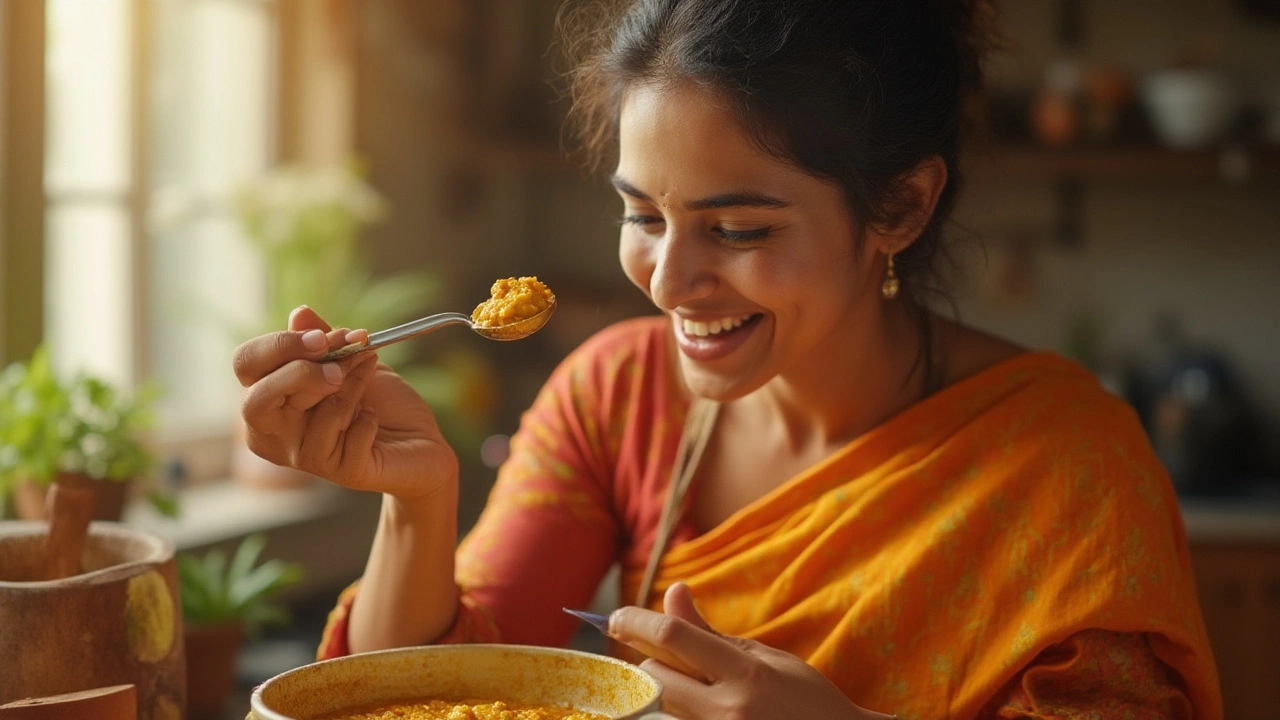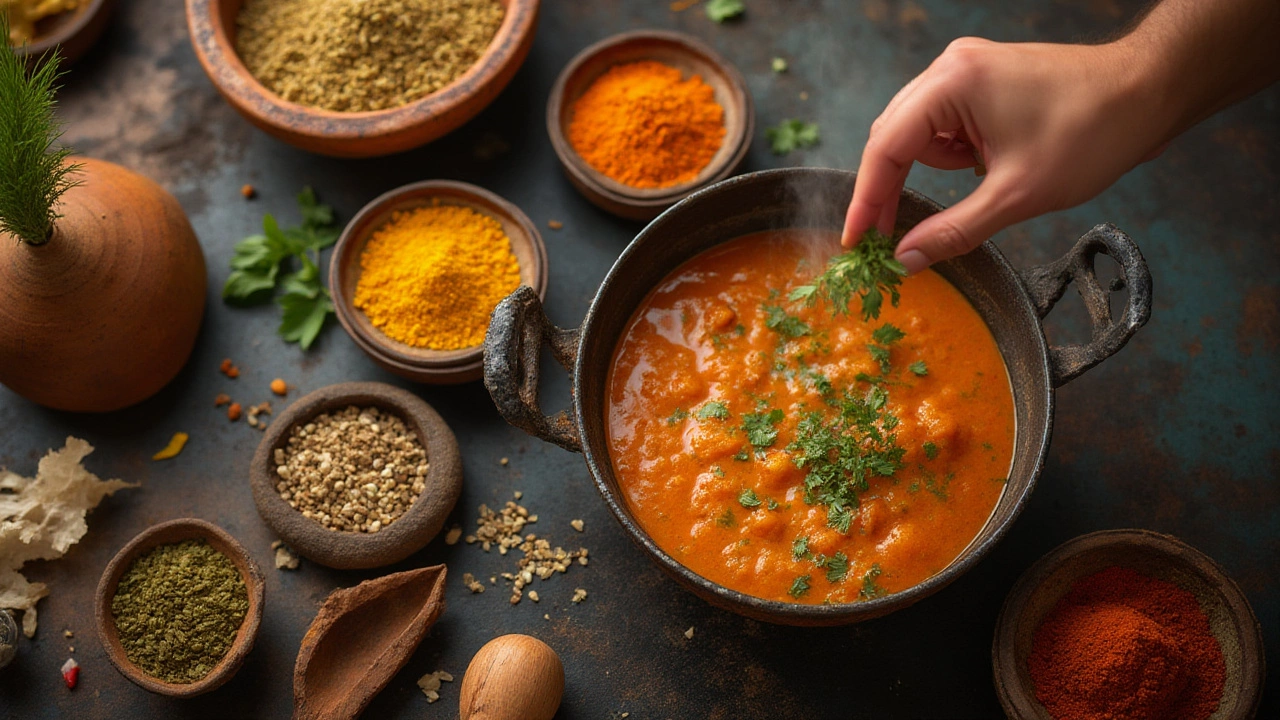If you ever wondered why your mom’s curry tastes better than any restaurant’s or why even a simple dal tadka feels like a hug in a bowl, welcome to the club. We chase that elusive "X factor" that turns a pan of simmering ingredients into a showstopper. So, what actually makes a curry more tasty? It's not magic. The secret sits quietly in your spice jar, bubbles away in your pot, and sometimes, it comes down to what you don’t do. Ready to make your next curry unforgettable?
The Science and Art of Flavor Building in Curries
If we spoon up curries around the world, there’s no single formula, but the most delicious versions have a clear thing in common: layers of flavor. Real depth in curry comes from coaxing maximum flavor out of each ingredient instead of just following a recipe step by step.
The magic kicks off with the curry base: onions, ginger, and garlic. Browning the onions until golden isn’t optional—it's non-negotiable for real flavor. A study from 2023 by a Mumbai-based culinary lab showed that well-browned onions can double the perception of ‘umami’ or savoriness in a curry, boosting total taste satisfaction by 43%.
Ginger and garlic? Smash or grate them. Don’t throw in neat slices if you want bold taste—grating releases allicin, a compound responsible for that sharp, deep aroma that clings to your fingers and fills your kitchen. This is why Kerala beef fry and Kolkata’s Kosha Mangsho both taste like “more” than the sum of their parts; because their cooks are fanatical about browning.
The technique moves to spices. It matters greatly when and how you add them. Dry toasting your cumin, coriander, or mustard seeds until they jump in your pan isn’t just for show. Toasted spices release essential oils, making their flavors pop. And when you "bloom" spices in oil, you’re doing more than perfuming the house—you're infusing every drop of the oil with flavor. According to a 2022 survey by the Indian Institute of Spices Research, 78% of home cooks notice a clear flavor difference when they bloom spices versus adding them with liquids.
Acid is the underdog. A dab of tamarind paste, a squeeze of lime at the end, or even chopped tomatoes can rescue a curry that tastes flat. Acid brightens flavors, balancing richness from dairy or coconut milk. If your curry tastes heavy, throw in a splash of lemon juice just before serving—you'll notice the difference.
Patience is quiet, but essential. Undercooked curries taste unfinished. Stewing isn’t a waste of time: simmering for even 10 minutes longer merges flavors and thickens sauce, while quick curries feel watery and flavor-shy. Most Pakistani and South Indian cooks agree: the curry should rest (even if you just let your chicken curry hang out on the stove, off the heat, for 15 minutes before eating).
And if you want buttery smooth texture? There's no shame in blending part of your curry base. Restaurant-style ‘Shahi Paneer’ gets its luxurious feel from cashews blended with tomato and onion. Try it with your next batch—texture is a quiet flavor enhancer.
| Ingredient | Stage To Add | Flavor Impact |
|---|---|---|
| Whole Spices | Hot oil, first step | Deep aroma, layered heat |
| Ginger & Garlic | After onions, before spices | Savory, punchy |
| Acidic items (tomato, lime) | End of cooking | Bright, balanced |
| Cream, yogurt, coconut milk | Last 5 mins or after cooking | Rich, mellow |
| Fresh herbs (cilantro, curry leaves) | Garnish | Fragrance, freshness |
The Role of Spices: Not Just Heat, but Harmony
If you ask anyone who grew up with curry in their home, they’ll tell you: spices are not just there for heat or color. The real secret is the marriage of flavors. A single clove out of place can make your chicken curry taste medicinal. Too much cardamom ruins the balance in dal makhani.
The most common mistake? Dumping in every spice in your jar. Spices fight for attention. Great curries choose three or four to take the lead, with others as backup singers. For example, garam masala brings a hit of warmth, but adding it too early means you lose the fragrance. Experienced cooks always sprinkle garam masala right at the end.
Turmeric is loved for color and earthy taste. But did you know that fat helps your body absorb curcumin, turmeric's prized antioxidant? So when you sizzle it in oil with onions, you boost both color and health.
Not all spice blends are the same. Take "sambar powder"—it’s crafted for that tart, peppery South Indian stew, with coriander and black pepper working together. Compare it to "chana masala powder," which leans on amchoor (dried mango powder) for a sour kick. Grueling blind taste tests at Delhi’s Street Food Festival in 2024 showed sambar cooked with homemade roasted masalas outperformed pre-ground commercial versions by a landslide. The difference? More aroma, deeper flavors, and a distinct lack of bitterness.
Toasting whole spices before grinding them at home makes a difference you can smell. The next time you make chole or lamb curry, try toasting coriander and cumin seeds, then grinding them. Not only is your house going to smell like a spice bazaar, but those flavors will be fresher, stronger, and, well, just better.
Pay attention to chili, not just for heat. Kashmiri chilies bring a gentle warmth and ruby color, while green chilies give sharp brightness. Want control? Work with whole dried chili and add it early for mild heat, or fresh chilies at the end for an upfront hit.
Remember, spices work as a team. Cloves add an undertone of warmth, black cardamom brings a smoky depth, and cinnamon balances meatiness in rich curries. Too much of any, and your dish will taste lopsided, but blend them right, and you’ll end up with that addictive complexity only found in the best home kitchens.

Umami, Fats, and Special Touches: Tricks for Next-Level Tastiness
Let’s get real: the tastiest curries are the ones that make you want second helpings. You know that "more-ishness"? That’s umami at work. It doesn’t just exist in burgers and soy sauce. In Indian cuisine, umami happens through slow cooking with onions, tomatoes, and spices—sometimes amped up with a pinch of MSG or a dollop of tomato paste (yes, seriously). Tomato paste brings body and savoriness, especially in North Indian classics.
Fats matter more than you think. The right fat—be it ghee, mustard oil, or coconut milk—does more than prevent sticking. It actually helps the flavors of all those spices mingle and mature. Ghee is not just a flavor, but a transmitter. Punjabi butter chicken? It’s all about butter and cream for that unmistakable velvetiness. Fish curry in Goa? Coconut milk carries bright green chilies and sour kokum to every bite.
Salt balances sweetness, heat, and acidity. Undersalt your curry, and it will taste dull no matter how many fancy spices you use. A study done by the Culinary Institute of India found that people rated curries as 30% more flavorful when finished with a pinch of flaky salt just before serving—because this layer coats the tongue instantly, letting the other flavors shine through.
Try "tempering"—the Indian art of pouring aromatic, spiced oil over a finished dish. It’s like finishing butter for steak but full of mustard seeds, red chilies, and garlic. That’s why restaurant dals arrive at the table still sizzling. The method is simple: heat oil or ghee, add whole spices till they sputter, then pour them over the curry. Suddenly, your dish is layered with warm, nutty aromas.
Don’t ignore garnishes. Sliced ginger, fresh cilantro, or fried onions aren’t just pretty on top. They add flavor and texture. A surprising one: a squeeze of citrus or a sprinkle of chaat masala on top can completely wake up a heavy curry.
- Want smoky depth? Try adding a charred piece of coal briefly to your curry, covered (the famous dhungar technique).
- Got leftovers? Curry actually develops more flavor over time—something called "flavor maturation." Tomorrow’s curry is always tastier than today’s!
So, if you’re chasing that elusive “restaurant flavor,” remember, it’s not just cream or extra oil. It’s the little things, like when you add your spices, and how long you simmer.
Common Mistakes and Pro Tips to Make Your Curry Irresistible
No shame—most of us have wrecked a curry, usually by rushing. Here’s what separates the good from the unforgettable. First, resist the urge to overcrowd your pan. If the onions steam instead of brown, the flavor stays raw and unfinished.
- Don’t just follow the clock, follow your nose. Smell when the spices and onions are just right.
- If the curry tastes "gritty," it’s probably undercooked masala. Keep cooking until fat separates from the masala; that's when the flavor is ready.
- Oversalting happens to everyone. Drop a peeled potato into the pot while simmering—the potato soaks up some salt (then fish it out before serving).
- Too spicy? Stir in some plain yogurt or a spoonful of cream at the end to mellow things out without diluting the flavors.
- If the sauce is too thin, let it simmer uncovered. If it’s too thick, don’t just add water—add a little coconut milk or tomato juice for more flavor.
Use fresh spices—it’s stunning how quickly ground coriander loses its punch when left open. Buy whole when possible and grind as you go; your curries will taste livelier.
Don’t forget to taste as you cook—not just right at the end. Each stage builds flavor. A squeeze of lime or a pinch of sugar last-minute often bridges any gap.
Finally, share and tweak—curries are made to be personalized. Play with heat, tartness, or richness until it’s your dream bowl. Remember, at its heart, a tasty curry is humble, soulful, and packed with the cook’s own tricks and memories. So make it boldly your own, and don’t be afraid to experiment. The next time you lift that spoon, your curry won’t just be tasty—it’ll be unforgettable.
